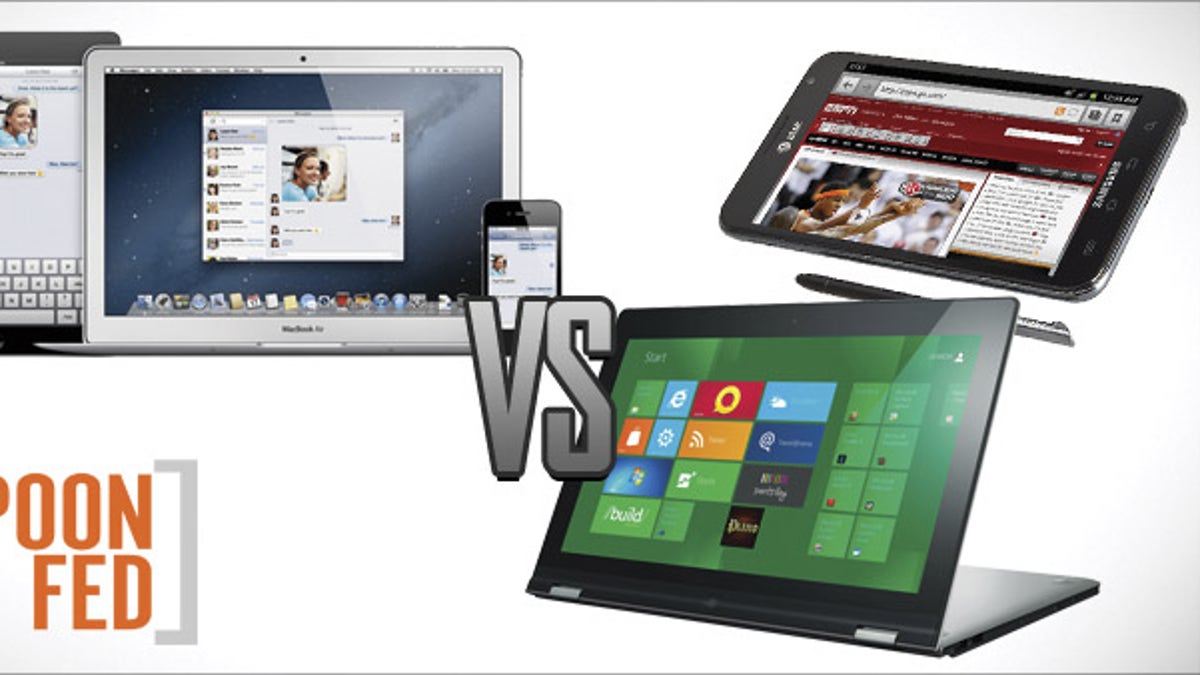
In a recent episode of the TV show "Fringe," a small town full of people suddenly starts going mad, in some cases growing duplicate limbs and even two sets of teeth. There's also lots of dead bodies. As it turns out in this sci-fi horror scenario, two universes are literally colliding, because both are trying to occupy the same space. That's exactly what's happening in the mobile tech world: two devices or two operating systems are trying to take the place of one. Apple is avoiding that carnage by going against the convergence grain with OS X Mountain Lion.
As we embark on the next era of mobile computing, gadgets are getting mashed together in aggressive and intriguing ways. Take the Galaxy Note from Samsung, which doubles as a phone and tablet. This combo device has some pretty compelling features, including integrated pen functionality for taking notes and marking up websites and other items for easy sharing. And thanks to the HD screen, you can comfortably view everything from books to videos.
However, the Galaxy Note is just too large for a phone. It's literally a two-handed device, which is a pretty significant trade-off for something that's designed to be one's primary communicator. The Galaxy Note also suffers from a lack of pen-enabled apps. There are some available such as Skitch from Evernote, but Samsung will need to attract a lot more developers in order to make hybrids like this palatable to the masses. (A rumored Galaxy Note tablet could help.)
On the software side, Windows 8 will attempt to be the brains of both laptops and tablets, which is a big gamble. Microsoft's OS has a fairly intuitive and engaging Metro interface that's similar to Windows Phone, but will also have a desktop mode for running traditional programs. Even Windows 8 tablets powered by ARM processors will be able to access the desktop, as well as run the upcoming Office 15. But Windows on ARM (WOA) won't support existing desktop apps built to run on x86/64 hardware. That means the onus is on Microsoft to ensure that its Windows Store is stacked with Metro-style apps in time for launch.
The new OS X Mountain Lion coming this summer takes a stand against extreme convergence by borrowing some of the best iPad features without trying to be one. Yes, you'll find iOS-style apps like Notes and Reminders, but there's only one interface in Mountain Lion and one desktop. And not all of the iPad-like features are integrated in the same way. Take Notification Center. Instead of dropping down from the top of the screen, it slides out from the right side so as not get confused with two-finger scrolling. Plus, Apple added an additional innovation in Mail called VIP that lets you decide whose email alerts flash on the screen to cut down on the clutter.
I'm not saying that going the 2-in-1 route will always fail — after all, smartphones combined the PDA with the cellphone — but it's dangerous when you don't respect that certain devices are built for different things. In the case of the Galaxy Note, it's trying to be your phone and your tablet while literally stretching the definition of the former too far. And with Windows 8, Microsoft is trying to have it both ways by marrying tablet computing with desktop computing. It remains to be seen whether consumers want this combination.
This week, NPD released a study on tablet usage, and it showed that only 10 percent of tablet owners have decided that they don't need a PC notebook. More than a quarter of nontablet owners said they were likely to buy a notebook in the next year, compared to 18 percent for a tablet. As analyst Stephen Baker summarized, most people "continue to hedge their bets on their device preference by planning to maintain an array of products to afford them maximum flexibility."
And that's exactly what Apple is doing with its product lineup. The MacBook Air will continue to sit alongside the iPad and the iPhone, with iCloud keeping users' data in sync across all of these devices. Do I wish the iPad were more like a laptop? Sure, a Smart Cover that doubled as keyboard would be nice. But that's just a borrowed feature, not a whole new type of device. Until there comes a time when consumers have to make little or no compromises, people will continue to want their notebooks and tablets, and smartphones and tablets to stay separate.
